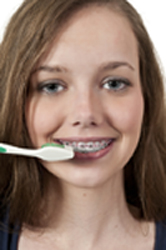- TYPES OF BRACES
- BRUSHING AND FLOSSING
- RETAINER CARE
- COMMONLY USED ITEMS
- SORENESS CAUSED FROM BRACES AND APPLIANCES
Brushing and Flossing your Teeth with Braces
 When you have braces, it’s very important to brush and floss after every meal in order to keep your teeth and gums healthy throughout your treatment. If you need help choosing the right toothbrush, toothpaste, and dental floss, please ask us and we can help you choose the right products for your teeth and your appliance.
When you have braces, it’s very important to brush and floss after every meal in order to keep your teeth and gums healthy throughout your treatment. If you need help choosing the right toothbrush, toothpaste, and dental floss, please ask us and we can help you choose the right products for your teeth and your appliance.
Brushing Instructions
Brushing: Step 1
Make sure your brush contacts and the enamel of your teeth. This will require more pressure than normal.
Brushing: Step 2
Brush vigorously in a circular motion to achieve maximum contact with your teeth. Use a soft brush to protect your gums. Be sure to brush your gums to prevent swelling from lack of stimulation.
Brushing: Step 3
Brush the outer, inner, and chewing surfaces of each tooth systematically to avoid missing any areas. We recommend you brush with water first to visually remove all food and plaque. Then brush with toothpaste with fluoride to protect the enamel.
Brushing: Step 4
Use the tip of your brush for the inner surface of your front teeth. Use your brush vertically for difficult and crowded areas to make sure your brush contacts the enamel surface.
Flossing Instructions
Flossing: Step 1
Using a piece of floss about 18 inches long, carefully thread the end between braces and wire. You may find a floss threader helpful.
Flossing: Step 2
Carefully floss around the braces.
Flossing: Step 3
Carefully floss around the gum areas.
Flossing: Step 4
Carefully floss around each tooth. If flossing is too difficult in certain areas, use a proxy brush instead. We will provide you with a sample at the start of treatment.





